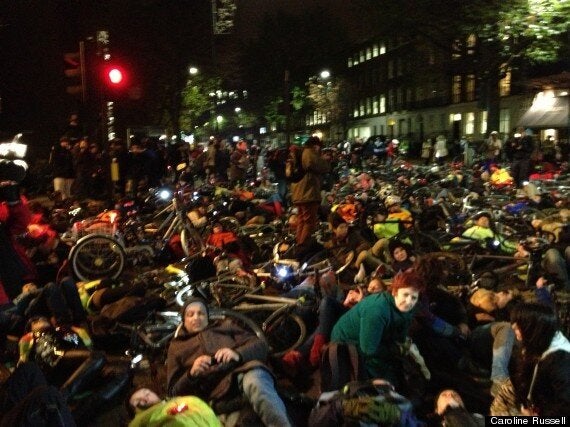Last Friday, along with at least a thousand others, I lay down in the road opposite Southwark tube station outside the offices of Transport for London.
I joined the #TfLDieIn on foot, without my bike, to remember all those who have lost their lives on London's roads. I particularly wanted to acknowledge the devastating toll in November: seven pedestrians and six cyclists have lost their lives in 13 crashes involving six lorries, four buses, a coach and two cars. No one driving any of the 13 vehicles involved lost their life. The asymmetry of power and risk is stark.
The reporting on the event has almost universally described it as a thousand angry cyclists protesting and calling for safe segregated space for cycling. Andrew Gilligan dismissed the die-in in his blog, before it had even happened, saying "It's starting to become a dialogue of the deaf" and then accused "the folk in the skull masks" of demand escalation.
Anyone who was at the event would not recognise Gilligan's caricature. The road was filled with people, quietly reflecting and listening to the most beautiful and haunting music from cellist Emma Butterworth and Opera Singer Louisa Beard. There was not a skull mask in sight. Arranged via Facebook, by Donnachadh McCarthy and others, the event was extraordinarily moving, it gave voice to victims and provided a calm opportunity for people to quietly bear witness to the awfulness of the recent deaths and express their hope for something better.
I lay on the rather cold tarmac with others who'd arrived on foot including Amy Aeron-Thomas and Sara Dowling of Roadpeace and Tom Kearney who miraculously survived a catastrophic crash with a bendy bus on Oxford Street, which left him in a near death coma.
We heard from Tom Kearney, who is determined that no family should go through what his family suffered in Christmas 2009, and from cycle campaigners. The names of people killed on London's roads, including the 13 people who have died in November, were read out.
Hope Fennel's mother, Nazan, spoke movingly about losing her 13-year-old daughter, on the way home from school in a collision with a lorry, on a pedestrian crossing. Hope was doing exactly as advised: wheeling her bike across the road at a pedestrian crossing to make her journey home safer - she was crushed by a heavy goods vehicle whose driver did not see her.
Nazan described the extraordinary situation where we have "lorries driving blind" through crowded city streets and asked how that can be acceptable? When you pause to consider the safety requirements on construction sites where lorries move at 5mph with a banksman on foot alongside, the fact that the same vehicles can move legally at 30mph with limited vision on London's busy roads, crowded with people, is bewildering. That they are killing and injuring people with such frequency is nothing short of scandalous.
The recent police activity to enforce the rules on driving-tired and road-worthiness of vehicles is to be welcomed but it needs to continue long term. If those in charge of the vehicles that can cause most harm feel there are no consequences for infringing the rules, we will continue to see further unnecessary deaths and injuries on our roads. And of course, every heavy goods vehicle driving through London should be fitted with technology that enables drivers to check their blind spots for the presence of people on foot and on bikes.
I wondered what the people watching from inside the Transport for London office made of the event. I hope that they will do just one key thing: overturn the dominance of the computer traffic model in decision-making. If we allow theoretical (modeled) vehicle capacity to trump all other requirements we will continue to live our lives alongside motorway-like roads. The mantra that vehicle-capacity must be maintained at any cost has to change; the price in devastated lives is too high. London could be so much better if we valued our streets as precious public space, treated vehicles as guests, not owners, and gave space and time to those getting around under their own steam whether on foot or by bike.

Many of us were there, not 'for cycling' but because we can see that London could be a more liveable city. We were there not as cyclists or as pedestrians but as people: mothers, fathers, daughters, sons, nieces, nephews, aunts, uncles and grandparents.
The current debate is focused too much on cycling and the behaviour of those who use bikes to get around. It needs to expand. We need to build a coalition of London residents who value walking and cycling and understand that pedestrians are at risk too. Otherwise we won't begin to reduce road danger or create a more liveable and less vehicle-dominated city.